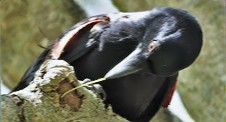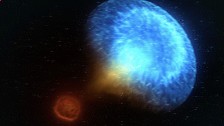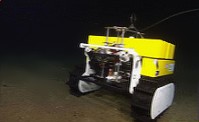http://www.rhci-online.net/radiogram/radiogram.htm
RSID: <<2018-01-
http://www.rhci-online.net/radiogram/radiogram.htm
RSID: <<2018-01-
26T02:25Z MFSK-32 @ WRMI SYSTEM B-STREAM-9955000+1500>>
START
IBC - ITALIAN BROADCASTING CORPORATION
mail: ibc@europe.com
http://www.ibcradio.webs.com
FB: @ITALIANBROADCASTINGCORPORATION
TW:
@RADIOIBC
|
|
|
RSID: <<2018-01-27T15:30Z MFSK-32 @ 9400000+1500>>
A chameleon-like material could be key to creating more powerful
computers ...
Sending Pic:101x83C;

Please report decode to
themightykbc@gmail.com

RSID: <<2018-01-27T16:01Z MFSK-32 @ 9400000+1500>>
Welcome to program 32 of Shortwave Radiogram.
I'm Kim Andrew Elliott in Arlington, Virginia USA.
Here is the lineup for today's program, in MFSK32 except where
noted:
1:32 Program preview (now)
2:51 Crows craft hooked tools*
6:35 Glow keeps growing after neutron stars
collide*
12:57 Olivia 64-2000: Deep sea mining
15:28 Olivia 32-2000: continued
18:44 Olivia 16-2000: continued
21:27 Olivia 8-2000: continued
24:04 Olivia 4-2000: continued
26:46 MFSK32: Image* and closing announcements
* with image
Please send reception reports to
radiogram@verizon.net
And visit http://swradiogram.net
Twitter:
@SWRadiogram
Crows 'Hooked' on Fast Food
VOA News
22 January 2018
WASHINGTON - Some New Caledonian crows craft hooked tools out of
branched twigs, and Scottish biologists have discovered why - the
birds can extract food from cracks and crevises several times
faster than by using straight twigs.
"It is a painstaking sequence of behaviors," explains Professor
James St. Clair, from the University of St. Andrews, the lead
author of the new study in the current issue of Nature Ecology &
Evolution. "Crows seek out particular plant species, harvest a
forked twig, and then, firmly holding it underfoot, carve, nibble
and peel its tip, until it has a neat little hook."
The Scottish team conducted experiments to record how long
wild-caught crows took to extract food from a range of
naturalistic tasks, using either hooked or non-hooked tool
designs. Depending on the task, they found that hooked tools were
between two and 10 times more efficient than non-hooked tools.
Although it takes the crow a while to create the hook, getting
food more quickly means it has more time and energy for
reproduction and avoiding predators. The researchers do not know
whether the hook-making know-how is inherited or learned by
observation, but because hooked-tool users will live longer and
leave more offspring, the skill is expected to spread.
https://www.voanews.com/a/crows-hooked-on-fast-food/4218509.html
Sending Pic:226x122C;

This is Shortwave Radiogram.
Please send reception reports to
radiogram@verizon.net
From Science News:
The X-ray glow keeps growing after the recent neutron star
collision
Emily Conover
24 January 2018
More than 100 days after two neutron stars slammed together,
merging into one, new telescope images have revealed that the
collision's lingering X-ray light show has gotten brighter. And
scientists don't fully understand why.
NASA's orbiting X-ray telescope, Chandra, previously picked up
the X-rays 15 days after gravitational waves from the cataclysm
reached Earth on August 17, 2017. The merged remnant then spent
several months too close to the sun for its X-rays to be seen.
When the remnant reemerged from the sun's veil on December 4, it
was about four times brighter than when it was last spotted,
Daryl Haggard of McGill University in Montreal and her colleagues
report January 18 in Astrophysical Journal Letters.
The glow may be tapering off. The XMM-Newton space telescope
found on December 29 that the X-ray signal may be starting to
weaken, according to a paper published January 18 at arXiv.org.
"The plot is about to thicken," says Haggard. Chandra has
collected new data to look for a drop in brightness.
Scientists are debating how to explain the enduring X-rays.
Neutron star collisions are expected to emit bright jets of
material, creating X-rays that fade quickly. The long-lasting
X-rays might be explained by a "cocoon" of debris), among other
possibilities.
https://www.sciencenews.org/article/x-ray-glow-keeps-growing-after-recent-neutron-star-collision
Image: X-rays generated in the collision of two neutron stars
(illustrated) have unexpectedly gotten brighter over time ...
Sending Pic:224x126C;

This is Shortwave Radiogram.
Please send reception reports to
radiogram@verizon.net
Next on Shortwave Radiogram, we will transmit content in the
following Olivia modes, all 2000 Hz wide:
Olivia 64-2000
Olivia 32-2000
Olivia 16-2000
Olivia 8-2000
Olivia 4-2000
For best results, please turn Fldigi's squelch (SQL) off.
About two minutes will be devoted to each mode.
Each of these modes has an RSID, so if RxID is selected, Fldigi
should automatically change to the correct mode and audio
frequency. If a manual mode change is required, all except Olivia
64-2000 require a custom setting in Fldigi: Op Mode > Olivia >
Custom > Bandwidth will always be 2000 Hz, while the Tones will
vary. For all the modes except 64-2000, a tuning signal of
approximately 30 seconds will be transmitted after the RSID to
provide time for the manual mode change, if it is required.
As the number of tones decreases, the speed of the text will
increase, but performance in shortwave conditions will
deteriorate.
The content is from Deutsche Welle:
http://www.dw.com/en/deep-sea-mining-charting-the-risks-of-a-new-frontier/a-42258847
Shortwave Radiogram now changes to Olivia 64-2000 ...
RSID: <<2018-01-27T16:12Z
OL 64-2K @ 9400000+1500>>
Olivia 64-2000 ...
From Deutsche Welle:
Deep sea mining: Charting the risks of a new frontier
Lars Bevanger
24 January 2018
The Earth's oceans hide vast amounts of valuable minerals and
metals, and as some onshore deposits run low, mining companies
are looking for ways to make deep sea mining both technologically
possible and profitable.
Changing to Olivia 32-2000 ...
RSID: <<2018-01-27T16:15Z
OL 32-2K
@ 9400000+1500>>
Olivia 32-2000 ...
This is partly driven by the need for so-called rare earth metals
to produce the magnets, batteries and microchips driving our
gadgets, electric cars and wind turbines.
"New technologies have initiated the new gold rush," says Andrea
Koschinsky, a professor of geoscience at Jacobs University in the
northern German city of Bremen.
"Many of the new technologies - for example magnets of the wind
turbines - need tons and tons and tons of rare earth elements."
Some deep sea mining machines have already been built, and many
countries have bought permits for deep sea mineral prospecting in
a massive 1.2 million-square-kilometer (463,322-square-mile) area
of the eastern Pacific Ocean.
Changing to Olivia 16-2000 ...
RSID: <<2018-01-27T16:18Z
OL 16-2K
@ 9400000+1500>>
Olivia 16-2000 ...
Environmental risks in a new frontier
Although no activity has started yet, environmentalists are
alarmed about the potential impact on ecosystems.
Koschinsky and her team are studying the impact of machinery
several kilometers down on the sea floor, where life has existed
for possibly billions of years and never before been disturbed by
man.
When she is not in her office, you might find her on a scientific
vessel, overseeing submarines and robots exploring the dark
depths of our oceans. This is the new frontier for mining
companies looking for metals which could soon be in short supply
onshore.
Harvesting 'potatoes'
Until now, deep sea mining has been hampered by high costs and
technological challenges. The most feasible method would be to
harvest so-called nodules - potato-shaped rocks made of manganese
oxide - from the flat sea floor some 4 kilometers (2.5 miles)
down.
Changing to Olivia 8-2000 ...
RSID: <<2018-01-27T16:21Z
OL 8-2K
@ 9400000+1500>>
Olivia 8-2000 ...
These could simply be picked up by specialized machinery, before
being brought to the surface to be processed."It is still
associated with high cost in the beginning, but once these
investments have been made - and some prototypes of
well-functioning machines exist - I think it should be possible
from both technological and financial sides," Koschinsky says.
Help from Wally the robot
Laurenz Thomsen is also a professor of geoscience at Jacobs
University, working alongside Koschinsky. Using a range of heavy
robots, he studies the impact their caterpillar tracks have on
the soft seafloor sediment.
This is mimicking what heavy mining machinery would do when
scurrying back and forth to collect the metal-rich nodules found
there.
They call one machine Wally - "because it looks a bit like the
robot in the Disney animation film WALL-E," he explains, as he
shows a yellow deep-sea robot equipped with a webcam and
measurement systems, for everything from temperature and pressure
to methane concentration and turbidity.
His team has been studying what they call "the snow" - tiny
particles that are whirled up when the seabed is disrupted.
"I'm responsible for analyzing particle behavior - how the 'snow'
forms," Thomson says. He's also looking at how this affects the
animals on the seafloor.
Changing to Olivia 4-2000 ...
RSID: <<2018-01-27T16:24Z
OL 4-2K
@ 9400000+1500>>
Olivia 4-2000 ...
"They are very fragile animals. They actively catch particles,
and you can only find these types of animals in the deep sea when
there's enough organic matter settling down."
Manganese oxide nodules do not represent the only mining
opportunity out there. So-called hydro-thermal vents, deep sea
chimney-like structures spewing out minerals straight from the
Earth's core, have also caught future prospectors' eyes.
Because of the warmer waters forming around these structures,
they can be home to complex ecosystems. Yet Koschinsky is less
worried about the possible impact on these areas from mining
operations.
"These organisms are adapted to relatively quick and drastic
changes," she says.
"They live in a toxic environment anyway," she explains. Such
systems are frequently hit by volcanic eruptions, and then a new
vent system comes up. "So they can probably recover relatively
quickly."
Better prepared than ever
Environmental organizations are warning against a rush to explore
resources hidden under the seabed, instead urging world leaders
to create vast ocean sanctuaries to protect life in our oceans
from further disruption.
A new study of current mining proposals around the world,
published in the journal Frontiers in Marine Science, warns of
"long-lasting and possibly unforeseen consequences."
In the paper, researchers at the University of Exeter and
Greenpeace highlight that there are still many "questions and
uncertainties" surrounding the deep-sea mining, including legal
issues and problems associated with predicting, then later
tracking, the scale of any effects.
Yet some scientists point out that this time, at least, we are
better prepared to avoid negative environmental impacts - unlike
damage that has resulted from the exploits of petroleum
companies, large-scale fisheries and onshore mining programs.
Shortwave Radiogram returns to MFSK32 ...
RSID: <<2018-01-27T16:27Z
MFSK-32
@ 9400000+1500>>
This is Shortwave Radiogram in MFSK32.
Please send reception reports to
radiogram@verizon.net
Image from the previous DW.com story: Wally, one of the robots
helping scientists map the impact of machines on the ocean floor
...
Sending Pic:199x122C;

Transmission of Shortwave Radiogram is provided by:
WRMI, Radio Miami International, http://wrmi.net
and
Space Line, Bulgaria, http://spaceline.bg
Please send reception reports to
radiogram@verizon.net
And visit http://swradiogram.net
Twitter:
@SWRadiogram
I'm Kim Elliott. Please join us for the next Shortwave
Radiogram.
http://www.rhci-online.net/radiogram/radiogram.htm
|
QTH: |
D-06193 Petersberg (Germany/Germania) |
|
|
Ant.: |
Dipol for 40m-Band & Boomerang Antenna 11m-Band |
|
|
RX for RF: |
FRG-100B + IF-mixer & ICOM IC-R75 + IF-mixer |
|
|
Software IF: |
con STUDIO1 - Software italiano per SDR [S-AM-USB/LSB] + HDSDR 2.76 stable [2017-02-02] - for scheduled IF-recording |
|
|
Software AF: |
Fldigi-4.00.12 + flmsg-4.0.3 images-fldigifiles on homedrive.lnk |
|
|
OS: |
German XP-SP3 with support for asian languages |
German W7 32bit + 64bit |
|
PC: |
MEDION Titanium 8008 (since 2003) [ P4 - 2,6 GHz] |
MSI-CR70-2MP345W7 (since2014) [i5 -P3560 ( 2 x 2,6GHz) ] |